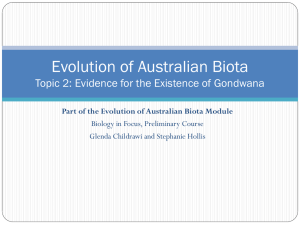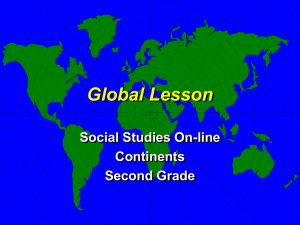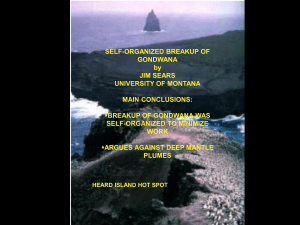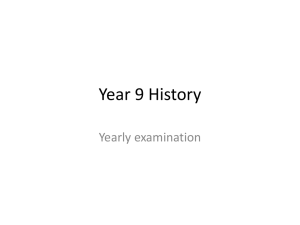1.1 Introduction to Evolution of Australian Biota
advertisement
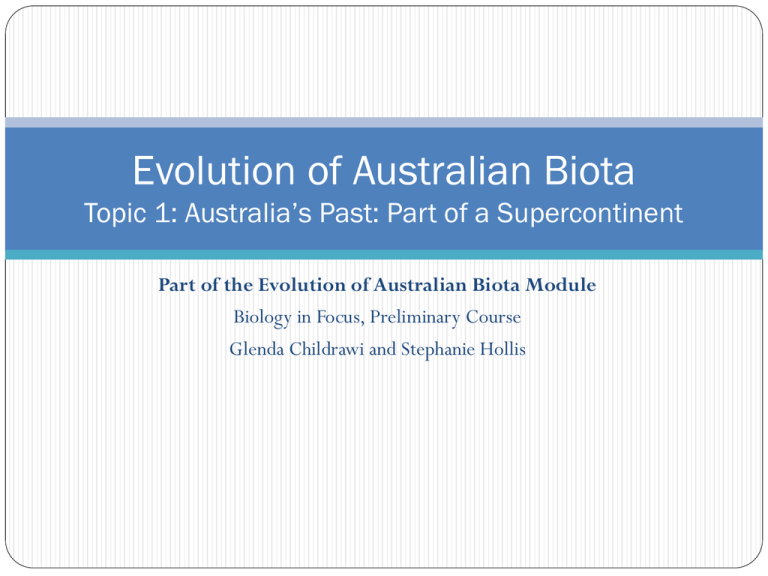
Evolution of Australian Biota Topic 1: Australia’s Past: Part of a Supercontinent Part of the Evolution of Australian Biota Module Biology in Focus, Preliminary Course Glenda Childrawi and Stephanie Hollis DOT POINT Identify and describe evidence that supports the assertion that Australia was once part of a landmass called Gondwana, including: Matching continental margins Position of mid-ocean ridges Spreading zones between continental plates Fossils in common on Gondwanan continents, includgin Glossopteris and Gangamopteris flora and marsupials Similarities between present-day organism on Gondwanan continents. Introduction In the last topic you studied the origin of living things on Earth, from 4500 million years ago until about 250 million years ago. In this Unit you will look at events that occurred in the late Paleozioc (300myo) but mainly the Mesozoic (23012myo) and Cenozoic (122myo). This was the time in which Australia broke away from a large land mass and became an island continent. conservapedia.com Introduction Alfred Wallace was a natural scientist in the mid 1800’s. He if famous for his work on evolution, but during his travels he also studied how geography affected the distribution of species of plants and animals. Today we call this biogeography people.wku.edu Introduction Wallace studied thousands of plants and animals and kept thorough records of where each was found. He recognised patterns in their distribution and this led to his proposal of two separate zoogeographical areas. The line separating these areas is called Wallace’s line. radford.edu Introduction Wallace’s line is a clear boundary that snakes between the Indonesian islands in the northwest and those in the southeast. He noticed that, despite having similar climate and terrain, the north-western islands (Sumatra, Java and Bali) had fauna, in particular bird species, more similar to those of the Asian mainland. convictcreations.com Introduction Whereas in the southeast, the birds in Lombok and New Guinea were more like those in Australia. At that point in time (1850ish), there was no explanation for this phenomenon but Wallace suggested that groups of organisms that were isolated evolved to become different. mail.colonial.net His line divides the Asian and Australian Regions that coincides with a deep mid-ocean ridge! Introduction In 1915, Alfred Wegener, a German scientist, noticed that identical fossils plants and animals had been discovered on opposite sides of the Atlantic Ocean. davidselvam.blogspot.com Introduction Knowing these organisms could not have crossed the ocean, he proposed the theory of continental drift, suggesting that all the continents had once been together forming a large single mass of land. He called this Pangaea. en.wikipedia.org Introduction He proposed that the continents then split up into smaller units of land which drifted to their current positions around the Earth. A large amount of evidence to support this theory has been found over the years. davidselvam.blogspot.com Introduction In this section, we will look at how the theory of continental drift could account for Australia becoming an island continent and the current evidence to support this theory. geekculture.com How Australia Arose from Gondwana Scientific studies over the past 100 years have led us to believe that continents have indeed moved. It is believed that 250 million years ago (mya), all the continents were joined together to form one huge land mass called Pangaea. indiana.edu How Australia Arose from Gondwana Forces beneath the surface of the Earth caused it to begin to break apart about 225mya. Pangaea is thought to have eventually given rise to the continents as we know them today. images.yourdictionary.com Lets have a look at the sequence of events How Australia Arose from Gondwana 225 mya: Pangaea splits into two land masses – Laurasia to the north and Gondwana to the south paralleldivergence.com How Australia Arose from Gondwana 180 mya: Gondwana begins to break up, as does Laurasia in the north. Australia is thought to have been part of the southern land mass and so we will follow the breaking up of Gondwana. davidselvam.blogspot.com How Australia Arose from Gondwana 135-100mya: Gondwana breaks into three parts Africa and most of South America Antarctica, Australia, New Zealand and New Guinea India (India began drifting northwards, towards the part of Laurasia that would become Asia. davidselvam.blogspot.com How Australia Arose from Gondwana 80 mya: New Zealand breaks away davidselvam.blogspot.com How Australia Arose from Gondwana 65 mya: Australia begins to separate from Antarctica (its still attached by Tasmania) davidselvam.blogspot.com How Australia Arose from Gondwana 60 mya: Final separation of the tip of South America from Gondwana davidselvam.blogspot.com How Australia Arose from Gondwana 45 mya: Australia becomes a separate continent and begins drifting northwards, and therefore becomes hotter and dryer. davidselvam.blogspot.com How Australia Arose from Gondwana There is both geological and biological evidence which supports this theory. Geological: -matching continental margins -position of mid-ocean ridges and spreading zones between them Biological: -common fossils -similar present-day organisms davidselvam.blogspot.com How Australia Arose from Gondwana Although the theory of continental drift was proposed over 100 years ago, finding sufficient evidence to support it has only come about fairly recently. It was only in the 1960’s that a theory was proposed that could account for how continents could drift. en.wikipedia.org How Australia Arose from Gondwana Harry Hess, a geologist, proposed the theory of plate tectonics. This theory provided an explanation as to how and why the continents could be moving. mnh.si.edu How Australia Arose from Gondwana He explained that continents were carried on large plates beneath the ocean. These plates were positioned on top of the semi-molten interior of the Earth. To understand this idea, picture a cracked eggshell surrounding the contents of the raw egg. thehawksnest.pbworks.com How Australia Arose from Gondwana The pieces of the eggshell represent the plates. As the plates move their boundaries may collide, slide past one another or move apart. If two pieces moved towards each other, they would converge on one side but a gap would form on the opposite sides of each. suu.edu Activity -Handout 1.1.1 Breaking up of Pangaea Diagram, students to glue into their books. -Visit the following website which shows an animation of the process of the breaking up of Gondwana and subsequent continental drift. http://kartoweb.itc.nl/gondwana/gondwana.html
